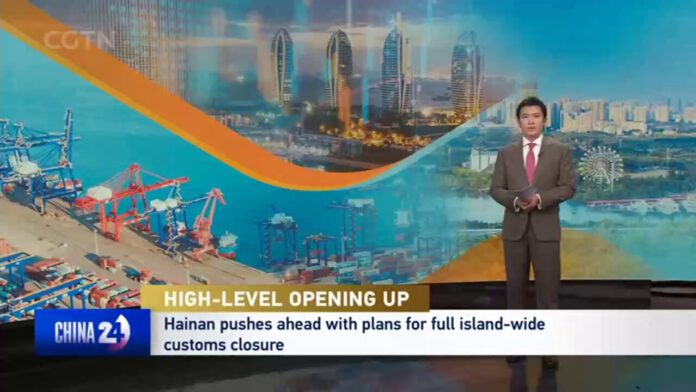
The full-island border closure of the Hainan Free Trade Port will officially begin on December 18, 2025. This announcement was made by Wang Changlin, Deputy Director of the National Development and Reform Commission, during a press conference held by the State Council Information Office on July 23.
The groundwork for this milestone was laid in June 2020, when the Central Committee of the Communist Party of China and the State Council issued the Overall Plan for the Construction of the Hainan Free Trade Port. The Plan proposed that by 2025, a comprehensive assessment would be carried out to evaluate Hainan’s readiness for island-wide customs closure, with the aim of identifying and addressing potential security risks. Once the necessary conditions were in place, the full customs closure would proceed, and existing special customs supervision zones such as the Yangpu Bonded Port Area and the Haikou Comprehensive Bonded Zone would be phased out.
The concept of customs closure refers to establishing a comprehensive, island-wide customs-regulated zone in Hainan. It is often described as opening the first line while controlling the second line, effectively making Hainan a region within the country but outside the customs jurisdiction. This configuration enables goods and items to benefit from preferential policies such as zero tariffs while under strict supervision. Under this system, the “first line” is the border between Hainan and foreign countries or regions, through which goods can enter or leave freely under lawful customs oversight. The “second line” refers to the boundary between Hainan and mainland China, across which goods will be managed according to import regulations.
Li Shijie, President of the Hainan Province Open Economy Research Association, emphasized that customs closure does not mean isolation, but rather a deeper level of openness to the world. After the closure, customs supervision will remain in place but will be more targeted and less interventionist. In essence, the closure mainly concerns goods, with the second-line closure meaning that additional customs checkpoints will be established between Hainan and other parts of the mainland. He noted that Hainan’s geographic position as an island with a relatively small economy makes it an ideal location for conducting institutional-level opening-up while minimizing systemic risks. Once closed, Hainan will be better aligned with high-standard international trade rules and institutional frameworks, making it more attractive to global resources and talent.
Li also highlighted the symbolic significance of December 18, the date chosen for the closure. It marks the opening of the Third Plenary Session of the 11th Central Committee of the Communist Party of China, which ushered in the era of reform and opening-up. Launching customs closure on this date underscores China’s intent to elevate reform and opening-up to a new level. In his view, decades from now, the development of the Hainan Free Trade Port will be regarded as no less significant than the opening of Shenzhen.
The implementation of customs closure is also a clear signal of China’s determination to expand its opening-up to the world. According to Yu Tao, Director of the Public Diplomacy and Hainan Opening-up Research Institute at the South China Sea Institute and a researcher at the Ministry of Propaganda’s Research Base for Overseas Cultural Exchange, the principle of “opening the first line while controlling the second” must be strictly followed. Goods entering Hainan without tariffs must be subject to import taxes if they are transported to the mainland. He pointed out that Hainan has already deployed 64 anti-smuggling law enforcement stations around the island to create a closed-loop defense line capable of effectively preventing and mitigating smuggling risks.
At the press conference, Wang Changlin also clarified that the customs closure will not impose additional administrative burdens on domestic travelers. Residents from other parts of China traveling to or conducting business in Hainan will not need special permits, maintaining the current level of ease in mobility.
With the closure approaching, the Hainan Free Trade Port is set to offer new opportunities for both businesses and individuals. According to current policy projections, the proportion of zero-tariff goods entering Hainan through the first line is expected to rise from 21% to 74%. The list of zero-tariff goods will expand from 1,900 tariff items to around 6,600. The vast majority of imported goods will thus enter Hainan without tariffs, value-added tax, or consumption tax. This policy is expected to lower commodity prices, increase the availability of high-value consumer goods, and offer both residents and tourists broader access to affordable, high-quality imports.
Back in 2020, Shen Xiaoming, then Governor of Hainan, noted that the tax burden on items such as yachts and entertainment equipment could be significantly reduced under the new system. For example, a yacht valued at 10 million yuan would previously incur 3.8 million yuan in taxes, but if imported through Hainan after the closure, these taxes would no longer apply. Entertainment equipment imports could see tax reductions of up to 20%.
Yu Tao noted that raising the proportion of zero-tariff goods to 74% will not only support business development but also enhance Hainan’s ability to develop a modern industrial system. The newly introduced “Prohibited and Restricted List” clearly defines what goods are barred or limited for import and export, reflecting a shift to the governance principle that “everything not explicitly prohibited is allowed.” This offers clearer operational guidance for businesses and increases regulatory transparency.
In terms of investment, Hainan will adopt a negative-list approach in line with international practices. For sectors not on the list, foreign entities will be free to invest. These investors will also benefit from a special policy allowing tariff exemptions for processed goods whose domestic value-added ratio exceeds 30%. According to Li Shijie, such policies are especially advantageous for high-tariff items like luxury goods and natural resources. These goods can enter China through Hainan using duty-free channels available to departing passengers or via processing under the 30% value-added exemption.
Hainan has also introduced a “dual 15%” income tax policy for both individuals and enterprises, significantly more favorable than the national standards. While most regions impose a 25% corporate tax and a progressive personal income tax with a maximum rate of 45%, Hainan offers a flat 15% rate for both, provided certain requirements are met. To qualify, individuals must reside in Hainan for at least 183 days annually, and companies must demonstrate substantial business activity on the island.
Li Shijie pointed out that Hainan’s zero-tariff advantages, combined with trade liberalization, international regulatory alignment, and the opening of free trade accounts, could help Chinese companies expand overseas. Given current global uncertainties, Hainan offers a stable and strategically positioned base for international operations.
A key enabler for cross-border capital flow is the EF account system—Hainan’s version of the free trade account. However, uptake has been limited, with only about 300 enterprises having registered EF accounts out of the 4 million market entities operating in the province. Li believes the current eligibility requirements are too restrictive and recommends easing the approval process to encourage broader adoption.
He also suggested further reducing the prohibited items list and simplifying the tax catalog to expand the scope of zero-tariff products. Additionally, expanding the list of encouraged industries could help cover more sectors in processing and manufacturing, thereby enhancing the island’s economic diversity and competitiveness.
Yu Tao emphasized that sustainable industry development is central to the success of the Hainan Free Trade Port. By fostering a world-class business environment that is market-driven, law-based, and international in character, Hainan can attract the businesses and talent needed for long-term growth. After customs closure, continuous optimization of the business environment will remain the top priority to ensure that Hainan’s transformation is not only successful but enduring.
Source: Xinhua, CGTN, Guancha, China Daily



